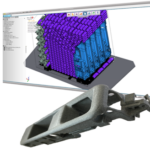Aston University is embarking on a project aimed at advancing the field of liquid metal casting through the development of a sophisticated mathematical model. The focus is on addressing a critical challenge associated with lightweight aluminum alloys – their rapid corrosion upon exposure to air. This issue has significant implications for emerging processes related to the additive manufacturing of light metals.
The transportation sector is witnessing a gradual shift from steel to lighter alloys. While these alloys resist rust, they exhibit swift oxidation when initially exposed to ambient conditions, impacting their quality and longevity. Dr. Paul Griffiths, a senior lecturer in applied mathematics, will lead a 12-month research project funded by £80,000 from the Engineering and Physical Sciences Research Council (EPSRC). The project, titled ‘Developing an accurate non-Newtonian surface rheology model,’ focuses on understanding the thin oxide films that form on alloys during the casting process.

Griffiths aims to create a mathematical model that effectively captures the intricate interaction between liquid metal flow and the oxide layer. This layer, behaving as a non-Newtonian liquid/gas interface, plays a crucial role in the casting process. The envisioned model seeks to describe surface characteristics such as velocity and shear profiles, as well as the effects of surface curvature. A more accurate mechanical model for the oxidized surface could enhance our comprehension of the encapsulation process, ultimately influencing alloy performance.
The research collaboration extends internationally, with a project partner in Grenoble, France. As the project unfolds, it holds the promise of refining liquid metal casting processes, contributing to advancements in 3D printing of light metals.
By unraveling the complexities of liquid metal flow and oxide layer interaction, this research anticipates a transformative impact on alloy encapsulation, shaping the trajectory of the industry towards increased efficiency and performance.
Come and let us know your thoughts on our Facebook, X, and LinkedIn pages, and don’t forget to sign up for our weekly additive manufacturing newsletter to get all the latest stories delivered right to your inbox.









